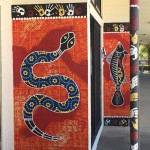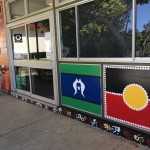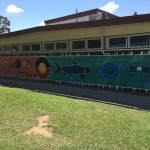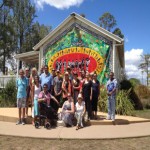Join us on the 3rd of November, 2018 for Yarnin’ Up.
All Bookings via Milford Lodge, Buderim, p: 5445 6228 or e: [email protected]
Join us on the 3rd of November, 2018 for Yarnin’ Up.
All Bookings via Milford Lodge, Buderim, p: 5445 6228 or e: [email protected]
Tune in and listen to my interview with Robyn Cook (The Kitchen Garden Teacher) as a part of her Stories from the Red Couch series. We are talking all things ‘career change’ on the Red Couch. Find out more about my journey over the past 2 decades and my work with Aboriginal and Torres Strait Islander communities within Education.
What it takes to get over the QCE finish line for our Aboriginal and Torres Strait Islander Students
In 2017, our Indigenous students are attaining their QCE at far higher rates than have in the past. With attainment rates at an all time high of 97.2% in parts of SE QLD, Indigenous students are graduating from Senior Schooling with more opportunity than those who have come before them. So what are the essential ingredients required to ensure their success? What are the barriers that limit their achievement and how can we ensure that those that do attain a QCE, go on to fulfil their potential.
Historically, the majority of Aboriginal and Torres Strait Islander children were never afforded a high level of education. Many Elders I have worked with over the past 20 years have shared that the Government policy and practice of the day reflected that of Social Darwinism. These Governments held a belief that meant many of our Elders were not educated past a Year 3 standard of education and were simply educated to be trained up as domestics or servants. At the age of 14, they would be sent to the many homesteads and properties throughout Queensland to act as slaves for the white station owners. Their employment was facilitated by the Government in response to ads placed in the Queensland Country Life magazine.
The next generation faced similar disadvantage. Up until the early 70’s, a State High School Principal could deny an education to an Indigenous student on account of their Aboriginality or Torres Strait Islander heritage. If they were accepted, many faced prejudice by educators who still carried this post colonial hangovers and in turn they struggled to reach their potential within this culturally unsafe environment.



Marsden SHS
Having recently travelled the state reviewing State schools, Independent Public Schools and Private schools, I was privileged to see, hear and feel what is and isn’t working well to support our Indigenous kids to attain a QCE. It’s not rocket science, but rather a blend of many different elements. In no particular order, here are the top 10 things you can do in your school to support Indigenous success and achievement.


Contact Sally Lawrence at [email protected] or call 0439 884988 for more information and support.
Marsden and Laidley SHS’s
Flying into 2018
Keep an eye out for some more exciting projects to finish off the year for Black Cockatoo, but first, check out the Taribelang Aboriginal corporation and what they have achieved.
Whilst 2017 has been somewhat quiet for Black Cockatoo, please note that 2016 and most of 2017 was spent working on projects for the Department of Education and Training. During this time, our team progressed a lot of work with many Aboriginal communities from South East Queensland and Wide Bay. Of particular note was the work we did with developing relationships and understanding of the Australian Curriculum with our Indigenous communities. Often I would hear community say,” The curriculum doesn’t represent and share our stories” and from Educators in schools, I would hear, “I don’t know where to start, who should I contact, what stories should we embed?”
With this knowledge, we developed a process similar to that of ‘speed dating’.
By inviting both the Indigenous community and Educators in schools to our events we started to identify opportunities within the curriculum that would support the local story. Firstly, we poured through each Learning Area and Year level in the Australian Curriculum to identify opportunities that were obvious and not so obvious to embed knowledge within. For us it was all about Acknowledging Country and ensuring that the local voices were being heard.
The ‘speed dating’ sessions also embraced the opportunity for our Indigenous community to be guided by school educators around the opportunities they saw for better alignment for the various workshops, talks, walks on country and activities that our Indigenous community were offering.
As a result of this day, the local Taribelang community and Elders of the Bundaberg region (QLD) have gone on to develop tours on country, taking educators to 4 culturally significant sites in and around Bundaberg. Their tours are ensuring that the local story is being embedded within the curriculum as Uncle Willie Broome gives permission to those on board to now embed within the curriculum.
Its outcomes like this that makes my heart sing!!

All aboard for Cherbourg’s Ration Shed Tours on the Most Excellent Adventures Tours for 2016
Aunty Honor Cleary and Uncle Marshall Saunders, along with Education Queensland’s North Coast Region Indigenous Education Unit, invite you to join in on the must do experience that will build your cultural awareness and understanding of life for many Aboriginal and Torres Strait Islander people living under the Act.
During this full day out, you will be guided by the Elders who share their personal stories of resilience, family and culture. All costs are included in the $70 per person cost. Transport, Elders fees, morning tea, entry to the Ration Shed Museum, 2 course lunch and wine tasting are included in the ticket price.
Bookings can be made for the following tours in 2016:
14th May – Saturday
8th August – Saturday
5th of November – Saturday
Bookings at [email protected]
or call (07) 5352 9250 Tuesday and Thursday to book
** These tours are subsidised by the Department of Education Training – North Coast Region’s Indigenous Education Unit
